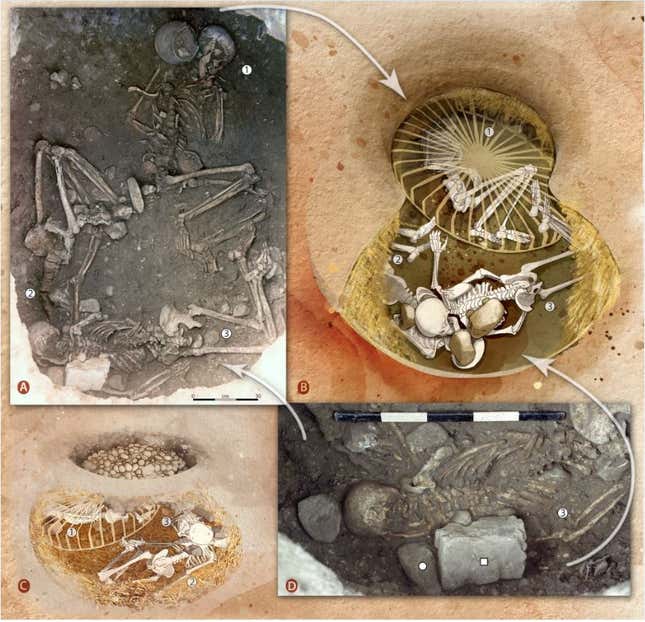Ritualized human sacrifice was common across Europe during the Stone Age, according to a team of researchers who recently tried to estimate the number of sacrifice victims on the continent.
They started by studying skeletons excavated at Saint-Paul-Trois-Châteaux, a Neolithic tomb in France’s Rhône Valley. Two of the remains belonged to women that the team determined were forced into positions that caused them to asphyxiate; at least one of the women may have been buried alive. The team then researched the frequency of similar burials across Europe, to determine whether the women’s apparent murders were ritualized. That further investigation found that squeezing the breath out of people was already a ritualized form of homicide for 2,000 years by the time the Rhône Valley victims died between 6,000 and 5,500 years ago.
“The principal challenge in archaeology, especially in prehistory where written records are absent, is distinguishing ritual sacrifice from other forms of ritualized violence,” the study authors wrote. Their research is published today in Science Advances.

Several indicators are straightforward: evidence that the dead were killed violently, that their remains were positioned unusually, or demographic irregularities in the dead individuals. Many bog bodies—well-preserved human remains discovered in ancient bogs, often in northern Europe—display signs of ritual sacrifice.
The silo at Saint-Paul-Trois-Châteaux that contained the skeletons was oriented toward the solstices, leading the team to their hypothesis that the site was venerated for agricultural purposes, evidently through human sacrifice.
“The specific arrangement [of the bodies]— stacked atop each other and entwined with fragments of grindstones — implies a more forceful and deliberate placement, strongly suggesting that their demise likely occurred within the burial context,” the team wrote.
They documented instances of homicidal ligature strangulation across Europe. This form of ritualized violence generally involves binding the prone victim’s ankles and throat together; the position of the victim causes them to self-strangulate. Besides the archaeological contexts, Mesolithic rock carvings in the Addaura Cave in Italy depict this form of human sacrifice.
The team studied 20 individuals at 14 other sites, from modern-day Spain to the Czech Republic and as far north as Germany to as south as Sicily. The sites range in age from 5400 BCE to 3534 BCE. Four of the apparent sacrifice victims were children, three of whom were at the same site in Spain, Bobila Madurell Sud.
“This cultural phenomenon could have diversified in Central Europe and structured itself at different rates for almost two millennia before culminating in the late Middle Neolithic,” the team concluded.
Even if that method of sacrifice was most in vogue in the Stone Age, sacrificial practices persisted for millennia. In 2019, an English water utilty company found over two dozen 3,000-year-old skeletons that showed signs of of human sacrifice: some of the individuals had their hands bound, severed feet, and were decapitated.
As for the community at Saint-Paul-Trois-Château: I’d say I hope their harvest was bountiful, but then they may have thought the sacrifices worked.
More: Ritual Sacrifice of 137 Children Found at 15th-Century Archaeological Site in Peru

